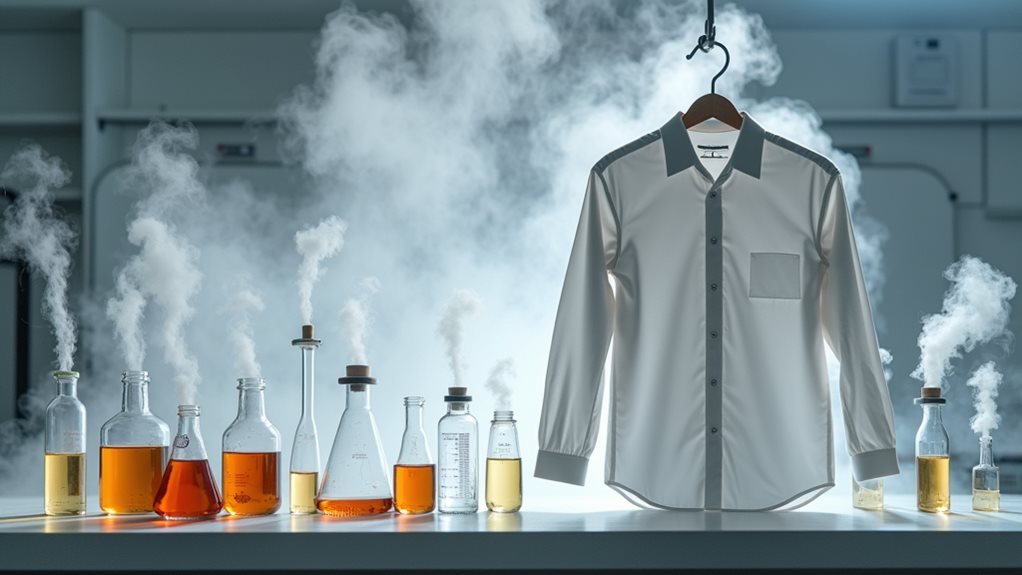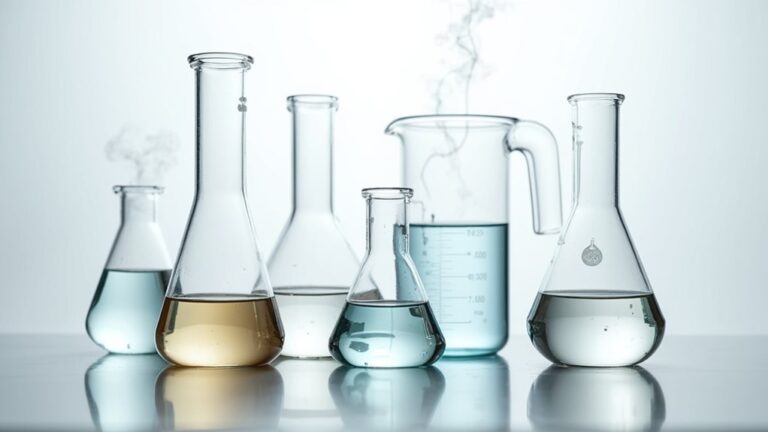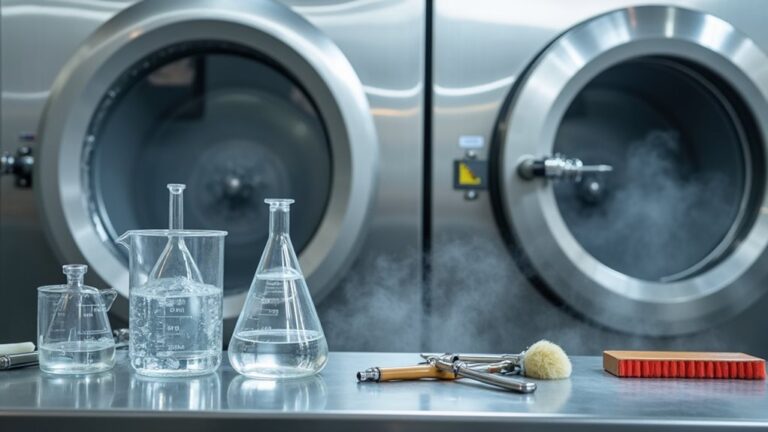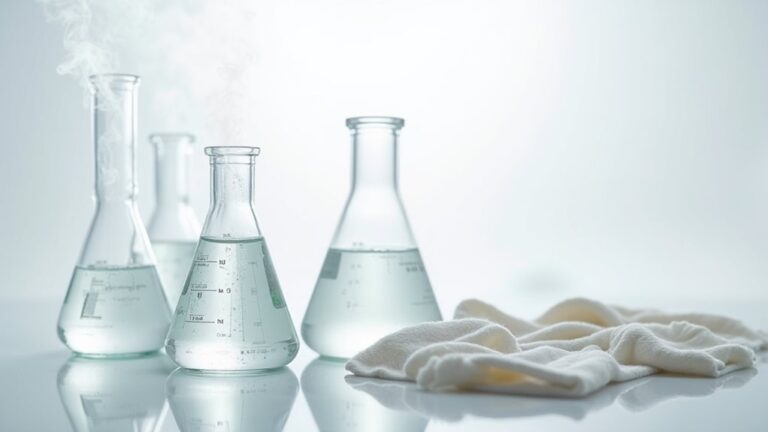Yes, dry cleaning chemicals can cause cancer, and you’re likely exposing yourself more than you realize. PCE (perchloroethylene) and TCE (trichloroethylene), the most common solvents used, are classified as probable and definite carcinogens respectively by health agencies. These chemicals increase risks of bladder cancer, non-Hodgkin lymphoma, and multiple myeloma, especially for workers but also consumers through off-gassing from freshly cleaned clothes that brings toxins directly into your home where they linger.
The Most Dangerous Chemicals Used in Dry Cleaning
The invisible threat lurking in your freshly pressed clothes might surprise you, because most people never think twice about what chemicals transformed their wrinkled shirt into crisp perfection.
Here’s what I discovered when researching the dry cleaning industry’s darkest secrets: PCE (perchloroethylene) dominates most shops, carrying serious cancer risks that’ll make you reconsider that weekly suit cleaning.
Even more alarming, trichloroethylene poses carcinogenic dangers so severe it’s classified as a definite human carcinogen.
These toxic chemicals don’t just threaten workers who handle them daily—they create residual exposure that follows you home.
The health effects include liver damage, kidney problems, and nervous system issues, making these invisible threats far more dangerous than that coffee stain you’re trying to remove! 😬
Studies suggest possible links to bladder cancer, esophageal, and cervical cancers, particularly among dry cleaning workers who face the highest levels of occupational exposure.
Cancer Risks Linked to Perchloroethylene and Trichloroethylene Exposure
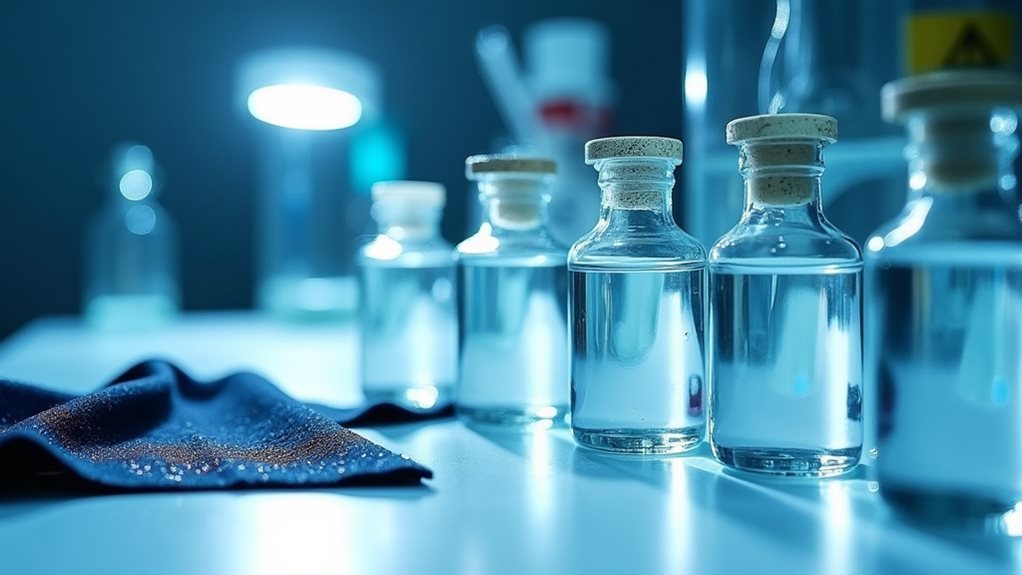
When scientists dig deep into cancer research, they’ve uncovered some truly sobering connections between dry cleaning solvents and serious health risks that’ll make your stomach drop.
Perchloroethylene (PCE) and trichloroethylene (TCE) aren’t just fancy chemical names – they’re genuine threats lurking in everyday dry cleaning operations. The International Agency for Research on Cancer has classified PCE as a probable carcinogen and TCE as a definitive one, which honestly sounds terrifying when you think about it.
These aren’t just chemical names on a label – they’re proven cancer-causing agents hiding in plain sight at your neighborhood dry cleaner.
Dry cleaning workers face increased risks of bladder cancer, non-Hodgkin lymphoma, and multiple myeloma from prolonged exposure to these solvents.
The Environmental Protection Agency has finally stepped up, acknowledging these serious health risks and pushing for regulatory changes to protect workers from these dangerous carcinogens.
Beyond occupational hazards, PERC exposure can also cause neurological problems, liver damage, and reproductive issues in the general population.
How Workers and Consumers Are Exposed to Toxic Solvents
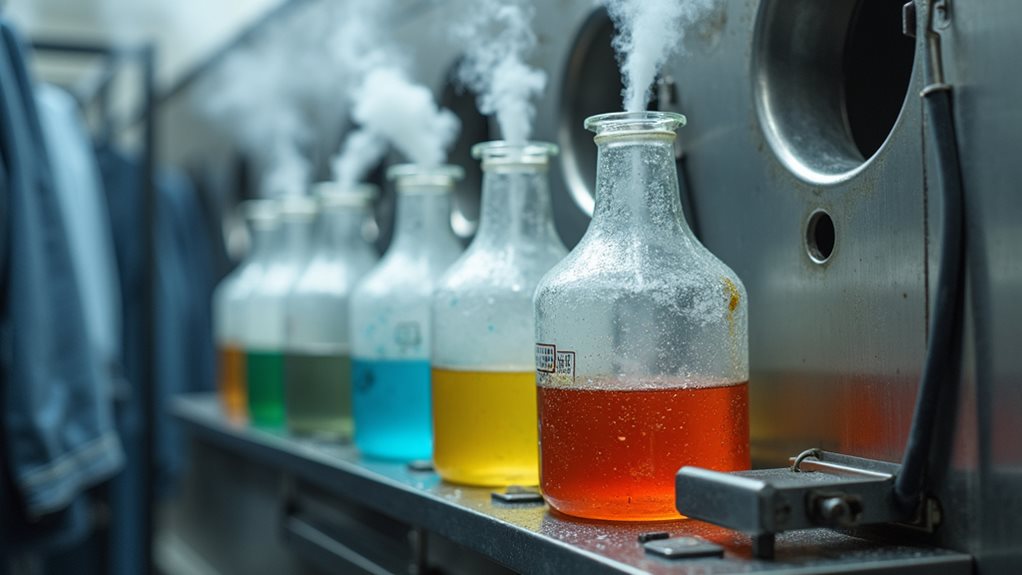
You might think the only people at risk from dry cleaning chemicals are the workers handling them all day, but the truth is that toxic solvents like PCE and TCE can reach you in ways that’ll surprise you.
Whether you’re breathing in fumes at work, bringing freshly cleaned clothes into your bedroom, or living near a facility where these chemicals seep into the surrounding environment, exposure happens through multiple sneaky pathways that most people never consider.
I used to hang my dry-cleaned suits right in my closet without a second thought 🤦♀️, not realizing that those “clean” clothes were actually off-gassing potentially carcinogenic chemicals into the air I breathed every night.
The risk is particularly concerning for items worn close to the skin, where PERC residues can cause skin irritation and allow for greater chemical absorption into your body.
Workplace Inhalation Risks
How often do you think about the air you’re breathing at work, especially if you’re among the thousands of Americans who handle clothes fresh from dry cleaning machines every day?
If you’re working in this industry, you’re facing serious health risks through inhalation of toxic chemicals like perchloroethylene (PCE), which the EPA classifies as a likely human carcinogen.
Workers exposed to these dry cleaning solvents show higher cancer rates, particularly non-Hodgkin lymphoma, bladder, and kidney cancers.
The daily routine of handling freshly cleaned garments means you’re breathing in these dangerous vapors, experiencing everything from immediate dizziness to long-term cancer risks that honestly keep me up at night thinking about workplace safety. 🏭
Fortunately, many eco-friendly cleaning methods like wet cleaning and CO2 cleaning are now available as safer alternatives that eliminate these toxic chemical exposures entirely.
Consumer Home Exposure
After you bring those freshly dry-cleaned clothes home, thinking you’re treating yourself to that crisp, professional look, you’re actually introducing a cocktail of toxic chemicals directly into your living space that can linger for days or even weeks.
Consumer exposure to dry cleaning chemicals like perchloroethylene creates serious health risks, turning your bedroom into an unintentional source of indoor air pollution.
These volatile chemicals don’t just disappear—they vaporize from fabrics, especially in poorly ventilated spaces, potentially causing respiratory issues and increasing cancer risks.
Consider these concerning realities:
- PCE concentrations can actually increase after multiple cleaning cycles
- Wool and cotton retain considerable chemical residues
- Carpets and upholstery absorb these toxins
- Headaches often signal ongoing exposure
Despite regulatory measures targeting these chemicals, many establishments still use them, making awareness your best protection.
PERC contamination extends beyond individual garments, as these chemicals can contaminate air, water, and soil, creating broader environmental health hazards for entire communities.
Environmental Contamination Pathways
While most people focus on the immediate smell of freshly dry-cleaned clothes, the real danger lies in understanding exactly how these toxic solvents travel from industrial machines into your body, creating multiple contamination pathways that can affect both workers and consumers for years to come.
Think of perchloroethylene (PCE) and other toxic solvents as invisible hitchhikers that disregard boundaries. These chemicals escape dry cleaning facilities through air vents, seep into groundwater, and cling stubbornly to your garments long after processing.
When you bring those “clean” clothes home, you’re fundamentally importing environmental contamination into your personal space, where vapors continue evaporating for days. This creates exposure pathways that can lead to cancer and acute and chronic health issues, affecting not only industry workers but unsuspecting consumers who simply wanted wrinkle-free clothing.
The health risks multiply when these chemicals accumulate in enclosed spaces. Exposure to these carcinogenic vapors can also cause neurological problems, liver damage, and respiratory issues, making dry cleaning facilities and contaminated environments particularly hazardous for long-term human health.
Regulatory Actions and Bans on Hazardous Dry Cleaning Chemicals
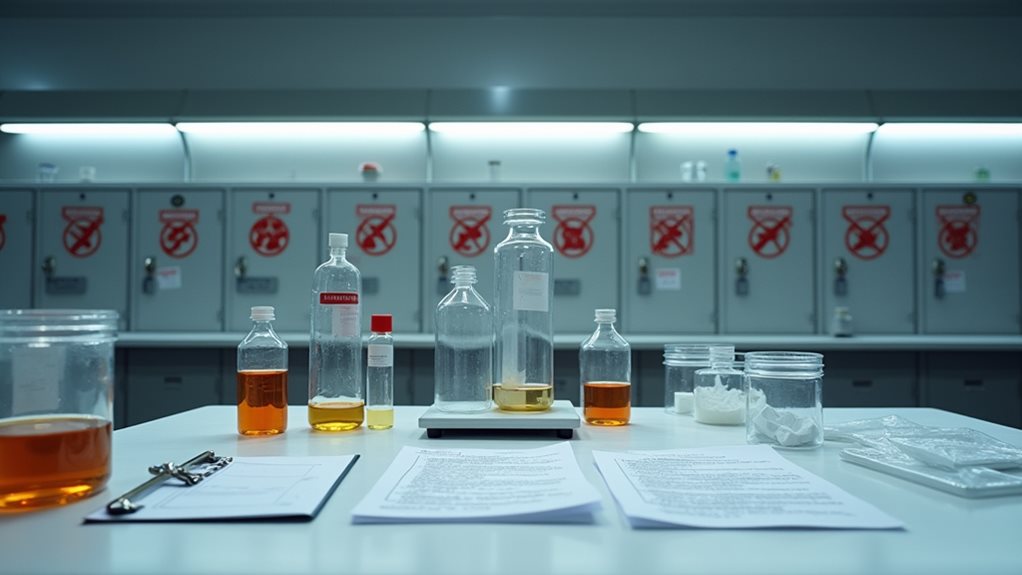
Given the mounting evidence about cancer risks from dry cleaning chemicals, government agencies have stepped up to protect public health through targeted bans and stricter regulations.
You’ve probably noticed fewer traditional dry cleaning shops around lately – that’s no coincidence! The EPA has finally banned those scary cancer-causing chemicals like trichloroethylene (TCE) and perchloroethylene (PCE) under the revised Toxic Substances Control Act.
These regulatory actions are happening because chemical exposure studies keep showing the same troubling patterns:
- TCE causes liver, kidney cancers, and non-Hodgkin’s lymphoma
- PCE damages immune, nervous, and reproductive systems
- Environmental contamination spreads beyond dry cleaning facilities
- Health risks affect workers and nearby communities
California’s leading the charge, phasing out PCE by 2023, though the industry’s pushing back hard on economic grounds.
In response to these bans, many dry cleaning businesses are adopting safer alternatives like hydrocarbon solvents and wet cleaning methods to continue operations while protecting public health.
Safer Alternatives to Traditional Dry Cleaning Solvents

Since those troubling regulatory bans are forcing the dry cleaning industry to evolve, you’re probably wondering what safer options exist for keeping your favorite silk blouse or wool suit looking pristine.
Thankfully, several safer alternatives are emerging to replace perchloroethylene (PCE) and trichloroethylene (TCE).
Wet cleaning uses water-based solutions that won’t harm your health, while liquid carbon dioxide offers chemical-free cleaning magic.
Propylene Glycol Ethers (PGE) are biodegradable and non-carcinogenic, making them a smart choice.
Siloxane (D5), found in GreenEarth® systems, is gentler than traditional solvents.
Hydrocarbon-based cleaners, derived from petroleum, provide another environmentally friendly option that effectively removes grease and oil stains while reducing health risks.
While these alternatives offer notable health benefits, adoption remains slow due to higher costs and fabric care concerns – but isn’t your wellbeing worth the investment?
Protecting Yourself From Dry Cleaning Chemical Exposure

Armed with knowledge about safer dry cleaning alternatives, you can now take proactive steps to shield yourself and your family from potentially harmful chemical exposure that might be lurking in your freshly cleaned wardrobe.
I’ll admit, I used to grab my dry cleaning and immediately hang it in my closet – rookie mistake! Those garments can harbor carcinogenic residues that compromise your health.
Here’s how you can minimize exposure to these chemicals:
- Ask your dry cleaner about their solvents and choose facilities using non-toxic alternatives
- Air out freshly cleaned garments outdoors before bringing them inside
- Never leave dry cleaning in enclosed spaces like your car
- Experiment with washing “dry clean only” items at home using gentle methods
These safer practices have genuinely transformed how I approach garment care, protecting my family from unnecessary chemical exposure. The good news is that chemical odors typically dissipate within hours when garments are properly ventilated, making this simple step highly effective for reducing exposure.

